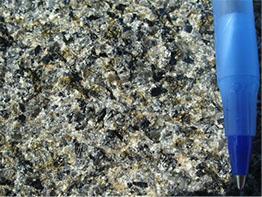By Anaïs Fourny
As isotopic and geochemical researchers, we seek the most accurate and precise analyses to describe and model the systems we study. However, in multiple collector-inductively coupled plasma-mass spectrometers (MC-ICP-MS), the sample matrix that is analyzed may affect the instrumental mass bias and result in inaccurate and irreproducible isotopic ratios (Nobre-Silva et al., 2009).
To control the accuracy and precision of geochemical analyses, the use of characterized reference materials with matrices similar to those of the unknown samples being analyzed is required (Weis et al., 2006). This is true for all matrices we analyze: whole rock, seawater, soils, or biological remains.
There are relatively few characterized plutonic rock reference materials, especially for rocks of ultramafic composition (i.e., those with high MgO and low SiO2, dominated by the minerals olivine and pyroxene). Quality control is particularly important during the analysis of mafic to ultramafic plutonic rocks in the Earth’s crust.
Due to the combination of their low to very low levels of trace elements, coarse grain textures, potential presence of refractory accessory minerals (e.g., chromite, zircon), and high contents of MgO, FeO, CaO, or Al2O3, these materials are more susceptible to both matrix effects and to sample heterogeneity that may make them difficult to completely dissolve by conventional acid digestion techniques (Fig. 1).

In this study, conducted at PCIGR, we report the mineralogical characterization, trace element concentrations, and lead (Pb)-strontium (Sr)-neodymium (Nd)-hafnium (Hf) isotopic ratios for 10 reference materials of mafic to ultramafic composition. These materials include a pyroxenite (NIM-P), five basalts (BHVO-2, BIR-1a, JB-3, BE-N, GSR-3), a diabase (W-2), a dolerite (DNC-1), a norite (NIM-N), and an anorthosite (AN-G). The composition of a plagioclase-rich leucogabbro from the Stillwater Complex, a large layered intrusion in Montana (USA), is also reported, as this sample contains zircon that is a new reference material for U-Pb dating of Archean rocks (Wall et al., 2016).
Trace element concentrations and isotope compositions were measured on unleached and leached powders of the basaltic materials to evaluate the effect of leaching on their reproducibility (Fig. 2). Mineralogical compositions were determined by XRD Rietveld refinements at the Electron Microbeam/X-Ray Diffraction Facility at the Department of Earth, Ocean and Atmospheric Sciences (UBC), to assess the potential role of the phases during leaching of basaltic samples and the potential relationship between mineral content and isotopic heterogeneity of the plutonic samples.
![Multi-element concentrations of the mafic-ultramafic rock reference materials normalized to Primitive Mantle [McDonough and Sun, 1995]](/sites/default/files/styles/large/public/2024-04/anais_2.png?itok=8S6DCOYc)
The analytical instrumentation utilized at PCIGR included three MC-ICP-MS (Nu Instruments Ltd.; Nu Plasma, Nu Plasma II and Nu Plasma 1700) (Fig. 3), two thermal ionization mass spectrometers (TIMS, Thermo Scientific [formerly Finnigan] Triton and Nu Instruments TIMS), and a high resolution-ICP-MS (HR-ICP-MS, Thermo Scientific Element 2).

For some of the reference materials, there were few to no previously published isotopic compositions. The results also supplement published trace element compilations with values for 40 trace elements from individual samples. Seven of the reference materials show excellent reproducibility for most element concentrations and isotopic systems (Fig. 4). The other three reference materials show variations that can be attributed to a variety of factors, including post-crystallization Pb mobility and the presence of accessory zircon.
Based on these results, we were able to present recommendations for the appropriate basaltic and mafic-ultramafic plutonic rock reference material to be used, depending on the isotopic system of interest, the sample matrix, and whether the samples are leached.

In conclusion, these results form a comprehensive new dataset that is essential for the isotopic investigation of mafic-ultramafic rocks in volcanic (e.g., mid-ocean ridge basalt, ocean island basalt, arc basalt, continental flood basalt, lunar mare basalt) and plutonic (e.g., lower oceanic crust, ophiolites, mantle xenoliths, layered intrusions, anorthosite complexes, lunar ferroan anorthosite) settings. Click here to view the full publication.
References
Nobre-Silva, I.G.N., Weis, D., Barling, J., and Scoates, J.S., 2009. Leaching systematics and matrix elimination for the determination of high-precision Pb isotope compositions of ocean island basalts. Geochemistry, Geophysics, Geosystems, 10(8): Q08012.
Wall, C.J., Scoates, J.S., and Weis, D., 2016. Zircon from the Anorthosite zone II of the Stillwater Complex as a U–Pb geochronological reference material for Archean rocks. Chemical Geology, 436: 54–71.
Weis, D., Kieffer, B., Maerschalk, C., Barling, J., de Jong, J., Williams, G.A., et al., 2006. High-precision isotopic characterization of USGS reference materials by TIMS and MC-ICP-MS. Geochemistry, Geophysics, Geosystems, 7(8): Q08006.